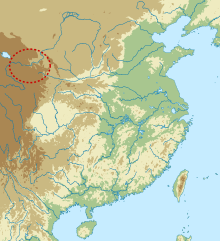Kultura Majiayao
Kultura Majiayao (chiń. upr. 马家窰文化; chiń. trad. 馬家窰文化; pinyin Mǎjiāyáo wénhuà) – chińska kultura neolityczna. Datowana na okres 3100-2700 p.n.e.[1], obejmowała w przybliżeniu obszar dzisiejszych Gansu, Qinghai i Ningxia[2]. Przez niektórych badaczy uważana jest za odgałęzienie kultury Yangshao[3]. Jej pierwsze pozostałości odkryto w 1923 roku w powiecie Lintao w prowincji Gansu[4].
Charakterystyczną cechą kultury Majiayao jest bogato zdobiona czarną farbą ceramika, na której malowano abstrakcyjne wzory oraz postaci zwierzęce i ludzkie[5]. Na jej stanowiskach odkryto również najstarsze w Chinach narzędzia wykonane z miedzi i brązu[6].
Przypisy
- ↑ Li Liu: The Chinese neolithic: trajectories to early states. Cambridge: Cambridge University Press, 2004, s. 224. ISBN 0-521-81184-8.
- ↑ Vadim Mikhaĭlovich Masson: History of civilizations of Central Asia. T. 1. Delhi: Motilal Banarsidass Publishers, 1991, s. 158. ISBN 81-208-1407-X.
- ↑ Gregory Eliyu Guldin: Anthropology in China: defining the discipline. Armonk, New York: M.E. Sharpe, 1990, s. 86. ISBN 0-87332-833-7.
- ↑ Histoire de l'humanité. T. 2. Paris: UNESCO, 2001, s. 708. ISBN 2-84-129790-X.
- ↑ Sigfried J. de Laet, Ahmad Hasan Dani: History of Humanity: From the third millennium to the seventh century B.C.. London: Routledge, 1996, s. 716. ISBN 978-92-3-102811-3.
- ↑ Miriam T. Stark: Archaeology of Asia. Malden, MA: Blackwell Publishing, 2005, s. 164. ISBN 978-1-4051-0213-1.
Media użyte na tej stronie
Autor: Kanguole, Licencja: CC BY-SA 4.0
Area of the Majiayao culture (3300–2000 BC) in northern China, based on Liu Li and Chen Xingcan (2012), The Archaeology of China: From the Late Paleolithic to the Early Bronze Age, Cambridge University Press, ISBN 978-0-521-64310-8, p214.
Autor: Editor at Large, Licencja: CC BY-SA 2.5
Painted Jar
- Majiayao Culture
- Late Neolithic Period (3300 - 2200 B.C.)



